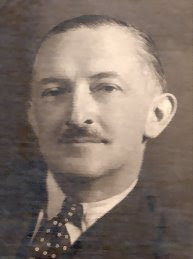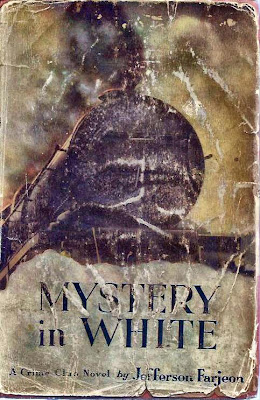 | |
| No, it's not the Orient Express.... |
"It snowed all day and all night. On the 22nd it was still snowing. Snowballs flew, snowmen grew. Sceptical children regained their belief in fairyland, and sour adults felt like Santa Claus, buying more presents than they had ever intended. In the evening the voice of the announcer, traveling through endless white ether, informed the millions that more snow was coming....
More snow came. It floated down from its limitless source like a vast extinguisher. Sweepers, eager for their harvest, waited in vain for the snow to stop. People wondered whether it ever would stop."
--Jefferson Farjeon, Mystery in White (1937)
 |
| A classic English mystery setting |
People stranded in a country house cut off from the outside world by snow, with murderous events afoot. It's a classic and beloved Golden Age murder mystery scenario and it's one Jefferson Farjeon used in his 1937 thriller Mystery in White. To top it all off, the tale takes place over Christmas eve and Christmas day.
As the splendid dust jacket reveals, a train is involved too, albeit briefly. Like Agatha Christie's Orient Express, this train gets stalled by snow. Five passengers--a clerk, a chorus girl, an elderly paranormal investigator and a genteel brother and sister--make their way off the train with their luggage to find a connection at a nearby station.
The wayfarers get lost in the snow, of course, but providentially they come upon a large country house, front door unlocked. No one seems to be in the house (though what was that noise in the attic?!), but fires are set and the table is properly laid for tea (though what's that bread knife doing on the floor?!).
 |
| Was the bread knife used on something besides bread?! |
In short, we, the readers, are encountering a favorite Jefferson Farjeon thriller scenario: stranded people encountering mystery and murder in an isolated building (this pattern goes all the way back to the author's 1920s mystery play No. 17, later filmed by Alfred Hitchcock; see also such novels as Sinister Inn and The Windmill Mystery). Queer noises occur, strangers--some perhaps malevolent--wander in and out, mysterious circumstances pile up like the snow drifts outside the house. By adding Christmas to the mix, Farjeon has made a cozily creepy crime confection for our delectation. It's not over-taxing for the brain, but it's quite enjoyable nonetheless.
 |
| Dorothy L. Sayers declared Jefferson Farjeon "quite unsurpassed for creepy skill in mysterious adventures" |
"Jefferson Farjeon is quite unsurpassed for creepy skill in mysterious adventures," Dorothy L. Sayers once proclaimed of one of her favorite mystery writers, gifting Farjeon's publishers on both sides of the Atlantic with a pleasing blurb for years to come. Other critics who shared Sayers' esteem for Farjeon were the American author and playwright Paul Wilstach ("Jefferson Farjeon writes corkers....He inevitably gives delight") and the American critic and scholar William Lyon Phelps ("Jefferson Farjeon is one of my favorite providers of murder. He knows how to give distinction...by an excellent literary style").
English thriller tales from the 1920s and 1930s generally have a bad reputation today, frequently being condemned for their exhibitions of racism and xenophobia. Certainly this is true of much of the work of the egregious Sydney Horler, say, or the more talented but still sometimes admittedly quite objectionable H. C. McNeile ("Sapper").
 |
| Some Golden Age crime thrillers by Sapper have a rather unpleasant edge |
 |
| H. C. McNeile ("Sapper") creator of Bulldog Drummond |
 |
| Jefferson Farjeon a kindler, gentler English thriller writer |
In Mystery in White, Farjeon presents his chorus girl and clerk with empathy (in one chapter a Walter Mitty-like fantasy sequence representing the fever-dream of the clerk is quite amusingly done), though in this one the genteel brother and sister play more active roles. Events get quite tangled, but all finally is revealed (though not really deduced). The dilatory police eventually do show up near the end of the novel, but in another resemblance to Agatha Christie's And Then There Were None England's finest don't get things quite right.
 |
| Mystery in White (1937) shares a certain affinity with The Mousetrap (1952) |
In addition to And Then There Were None, Mystery in White also somewhat resembles the celebrated Christie play The Mousetrap, though it must be admitted that it's neither as clever nor as sinister. But Christie fans (and all "cozy" English mystery fans) should enjoy this representative Farjeon tale. It's not his best, but it makes a nice holiday Golden Age mystery treat.
For more on Jefferson Farjeon, see http://thepassingtramp.blogspot.com/2011/11/another-pass-by-jefferson-farjeon-1883.html and http://thepassingtramp.blogspot.com/2011/11/passing-tramp.html
 |
| My ex-library copy of Mystery in White (obviously nearly read to death) |

Not an author I've ever come across but Farjeon has been added to the ever expanding list... Thanks for an excellent post.
ReplyDeleteI will make it a point to sample some Jefferson Farjeon's work in the upcoming year, and hopefully I will be able to track down a copy of Holiday Express. And even if it's not within easy grabbing range, there are still one or two of his other novels available from more locally based book dealers.
ReplyDeleteThanks for this review, Curt!
I'll be looking for this book now. Thanks!
ReplyDeleteI've got Farjeon's 5.18 Mystery waiting for me in 2012. This sounds like something I'd enjoy. A touch of Priestley's Old Dark House in this? I even see shades of his father's work - have you read The Last Tenant? Another creepy house (with real ghosts!) and a gruesome crime.
ReplyDeleteI'm digging into my small pile of Herbert Adams books right now and he sounds like he fits into Farjeon's "kinder, gentler" school of detective novels of the late 20s and 30s. Can I borrow that term? So far I've only read two, but there are the young lovers that Adams loves to include and romantic entanglements are at the core of the plot - sometimes the murder motives. The emotional lives of the characters are very telling. There's so much passion and depth of feeling, sorrow and empathy, but Adams' never goes overboard into syrupy sentimentality. Just the right level of humanity.
Just found out this one's coming out as a British Library Crime Classic in November this year- perfect time for Christmas. They really are shaping up to be a fine imprint aren't they right down to the attractive design?
ReplyDelete